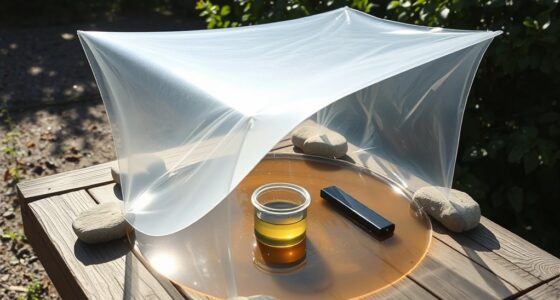To build an ultralight foraging kit for long-distance treks, focus on compact, multi-use tools like a small knife and foldable scissors, along with a lightweight field guide for plant ID. Carry breathable collection bags and durable, leak-proof containers. Learn to recognize safe edible plants and mushrooms by key features, always verifying before consuming. Practice sustainable harvesting and ethical foraging. For more tips on maximizing wild food opportunities, continue exploring the essentials tailored for your trek.
Key Takeaways
- Include lightweight, sharp tools like a folding knife and scissors for safe harvesting of edible plants and mushrooms.
- Carry compact field guides or apps for accurate identification of safe edible species and toxic look-alikes.
- Use breathable, leak-proof containers and nesting techniques to maximize space and ensure food safety during long treks.
- Practice ethical foraging by harvesting sustainably, avoiding protected areas, and verifying edibility before consumption.
- Incorporate signaling devices and reliable navigation tools for safety and emergency communication in remote environments.
Essential Tools for an Ultralight Foraging Kit
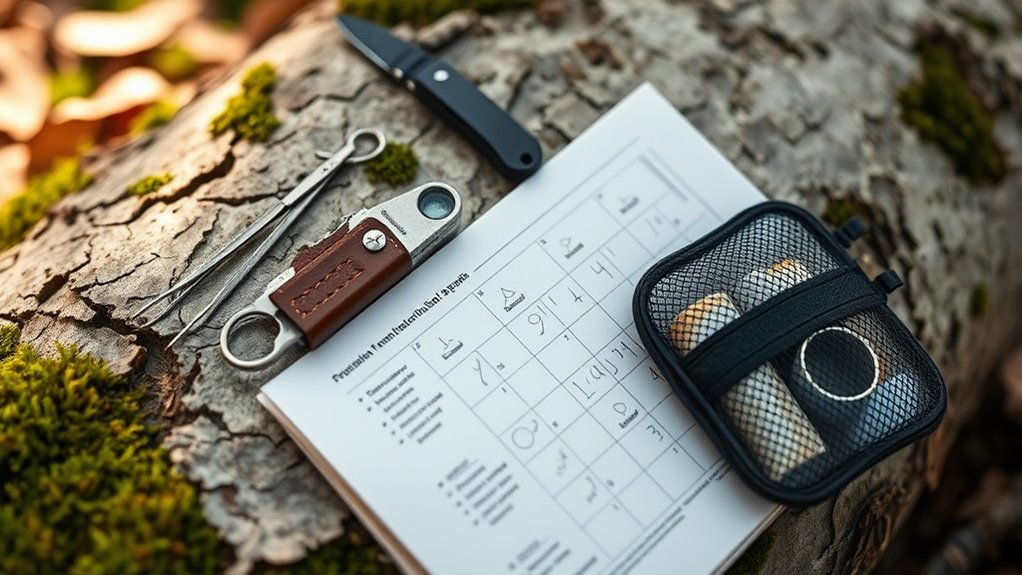
When assembling an ultralight foraging kit, choosing the right tools can make all the difference. Prioritize lightweight, multi-purpose items that support foraging ethics and responsible harvesting. A small, sharp knife is essential for safe and precise cutting, while a foldable scissors or pruning shears can help with delicate stems. A compact field guide for edible plant identification ensures you’re confident in your choices, respecting foraging ethics by avoiding overharvesting or endangered species. A breathable collecting bag or container keeps your finds secure without adding bulk. Remember, the goal is to minimize environmental impact while maximizing safety. Carefully selecting these tools helps you stay ethical and efficient, making your long-distance trek both enjoyable and responsible. Sustainable foraging practices are also vital to protect ecosystems and ensure future foraging opportunities.
Identifying Edible Plants and Mushrooms
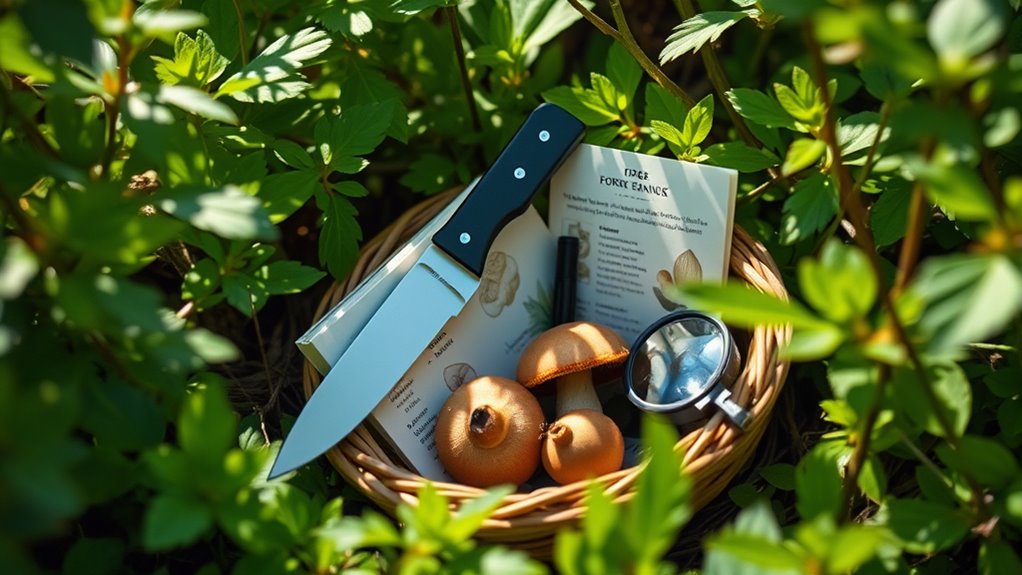
You need to confidently identify which plants and mushrooms are safe to eat. Learning to recognize key features helps you avoid toxic look-alikes. Being precise now can make all the difference in a survival situation. Familiarizing yourself with edible plant identification techniques ensures you can distinguish safe varieties from dangerous ones.
Recognizing Safe Edibles
Identifying safe edible plants and mushrooms requires careful attention to detail, as many wild varieties can look similar to toxic ones. To avoid accidental poisoning, learn key features that distinguish safe foods from poisonous plants and when mushroom identification is essential. Focus on the plant’s leaf shape, color, smell, and growth pattern, and always cross-reference with reliable guides. For mushrooms, pay close attention to cap shape, gills, stem, and spore color, since many edible and toxic species resemble each other. Remember, even experienced foragers can mistake poisonous plants or mushrooms if they’re not familiar with specific identification markers. When in doubt, it’s safest to avoid consuming any wild item unless you’re 100% sure of its safety. Proper recognition is critical for a safe, successful foraging experience. Additionally, understanding the contrast ratio of your viewing environment can help in accurately identifying subtle differences in plant or mushroom coloration, reducing the risk of misidentification.
Differentiating Toxic Look-alikes
Many wild plants and mushrooms share similar features, making it easy to confuse safe edibles with their toxic look-alikes. To avoid dangerous mistakes, rely on photo identification rather than just memory or assumptions. Take clear, close-up photos from different angles, noting key features like stem color, gill attachment, and leaf shape. Always cross-reference with trusted field guides or apps to confirm identifications. Practicing foraging ethics is essential—never consume anything you’re unsure about, even if it looks familiar. Remember, misidentifying a plant or mushroom can be deadly. When in doubt, leave it out. Developing a careful, methodical approach helps keep your foraging safe and sustainable during long-distance treks. Prioritize accuracy and respect nature’s boundaries at all times. Being aware of toxic look-alikes and their distinguishing features is crucial for avoiding accidental poisoning.
Safety Precautions and Ethical Foraging Practices

When foraging, you need to be confident in identifying edible species to avoid dangerous mistakes. Respecting nature’s balance means harvesting responsibly and only taking what you need. By following these practices, you help guarantee that foraging remains safe and sustainable for everyone. Incorporating recognition skills to accurately identify angel numbers can also enhance your awareness and decision-making during your outdoor adventures.
Identifying Edible Species
How can you guarantee you’re collecting edible plants safely and ethically? Start by learning to identify species accurately. Use wildlife tracking skills to observe plants and their environment—note leaf shapes, colors, and growth patterns. Be cautious with edible fungi; only pick those you can positively identify as safe, as many mushrooms resemble toxic varieties. Always consult reliable field guides or expert sources. Avoid foraging in protected areas or disturbing plant habitats unnecessarily. Respect seasonal cycles and plant health, taking only what you need. Remember, misidentification can be dangerous, so when in doubt, leave it be. Prioritizing safety and ethical foraging helps preserve ecosystems and ensures your long-distance trek remains sustainable and enjoyable. Additionally, understanding the Vetted – Textile Line helps ensure your foraging gear and apparel are eco-friendly and durable, supporting sustainable practices during your adventures.
Respecting Nature’s Balance
Practicing ethical foraging means you must prioritize the health of the environment alongside your safety. Respecting nature’s balance involves understanding wildlife conservation and adhering to foraging ethics. Avoid overharvesting; take only what you need and leave enough for animals and plant regeneration. Stay on established trails to minimize habitat disruption and prevent damage to fragile ecosystems. Never disturb wildlife or remove species that are protected or endangered. Be aware of local regulations and obtain any necessary permits. By following these principles, you help maintain biodiversity and ensure future foraging opportunities. Your actions directly impact the environment’s health, so always forage responsibly and with respect for nature’s delicate balance. Ethical foraging safeguards ecosystems for generations to come, emphasizing the importance of active environmental stewardship.
Materials for Signaling and Navigation
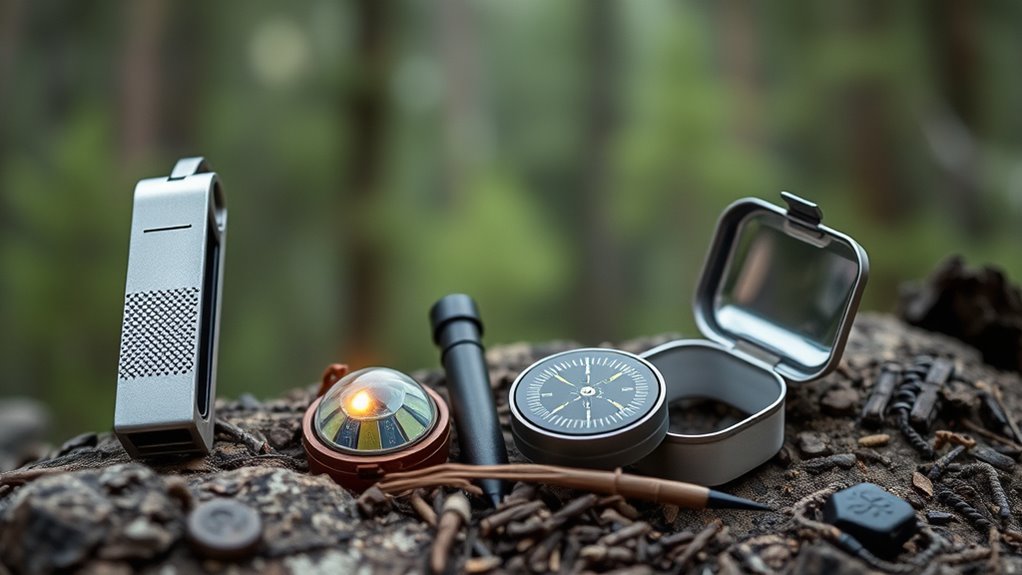
Choosing lightweight and reliable materials for signaling and navigation is essential to guarantee you can call for help or find your way back. Opt for compact signaling devices like a whistle, mirror, or small flare that are easy to carry and highly visible or audible. Navigation tools such as a GPS device, a lightweight compass, or an altimeter can help you stay on track, especially if your route becomes unclear. Select durable, weather-resistant options to assure they function in various conditions. Avoid bulky equipment; instead, focus on multi-purpose tools that save space and weight. Properly maintaining and familiarizing yourself with these materials beforehand guarantees quick, effective use when needed. Staying prepared with efficient signaling devices and navigation tools keeps you safe during your long trek. Regularly updating your knowledge of these tools can improve your response time in emergency situations.
Compact Containers and Storage Solutions
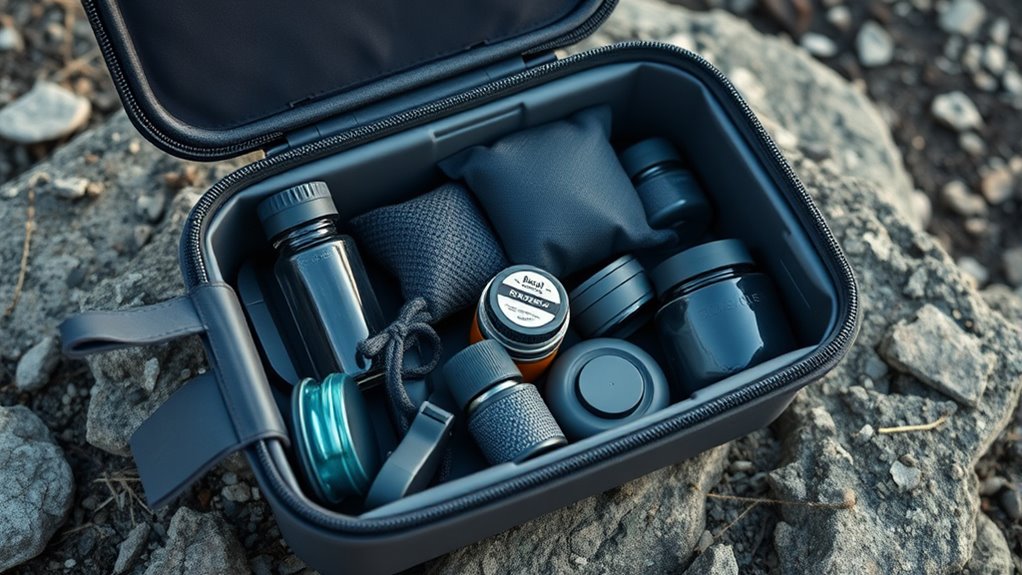
Choosing the right containers keeps your kit light and efficient. Look for materials that are both lightweight and durable, like titanium or certain plastics. Using space-efficient packing techniques and leak-proof designs guarantees your supplies stay safe and organized during your foraging adventures. Incorporating organized storage solutions helps maximize space and accessibility in your kit.
Lightweight Container Materials
When selecting containers for your ultralight foraging kit, prioritizing lightweight yet durable materials is essential. Lightweight metals, such as titanium or aluminum, offer strength without adding excessive weight, making them ideal choices. These materials resist corrosion and can withstand rough handling, ensuring your supplies stay secure. Additionally, biodegradable packaging options can reduce environmental impact, especially for short-term storage or waste containment. Look for containers made from BPA-free plastics or food-grade silicone that are both lightweight and resilient. Compact design is key, so choose containers that nest or stack efficiently. By combining lightweight metals with eco-friendly packaging solutions, you’ll keep your kit minimal, durable, and environmentally conscious during long treks.
Space-Efficient Packing Techniques
To maximize space in your ultralight foraging kit, selecting compact containers that nest or stack efficiently is essential. Use silicone collapsible bowls, stackable jars, or nesting spice containers to save space. These solutions are perfect for organizing edible insect recipes or ingredients for campfire cooking without adding weight. Consider packing smaller containers inside larger ones to optimize space further. For example, store spices or dried herbs in tiny jars nested within a larger container. Here’s a quick comparison:
| Container Type | Benefit | Best Use |
|---|---|---|
| Collapsible silicone | Saves space when empty | Dry ingredients |
| Stackable jars | Easy to organize | Edible insect recipes |
| Nesting spice containers | Compact for small items | Seasonings for campfire |
| Ziplock bags | Lightweight, versatile | Small snacks or ingredients |
| Compact canisters | Durable, space-efficient | Cooking tools or utensils |
Durable, Leak-Proof Designs
Durability and leak-proof performance are vital when selecting compact containers for your ultralight foraging kit. You need reliable storage that can withstand rough handling and prevent spills during trail adventures. Choose containers made from sturdy, puncture-resistant materials to guarantee they last through campfire cooking sessions and rugged treks. Leak-proof designs are indispensable for carrying liquids like water or homemade sauces, especially when preparing trail snack ideas that involve oils or spreads. For dry ingredients, opt for airtight containers that keep food fresh and prevent contamination. Compact, durable containers save space while offering peace of mind, so you won’t worry about leaks or breakage. Selecting containers with leak-proof seals ensures your foraging kit remains lightweight, organized, and ready for any outdoor culinary adventure.
Knowledge Resources and Field Guides
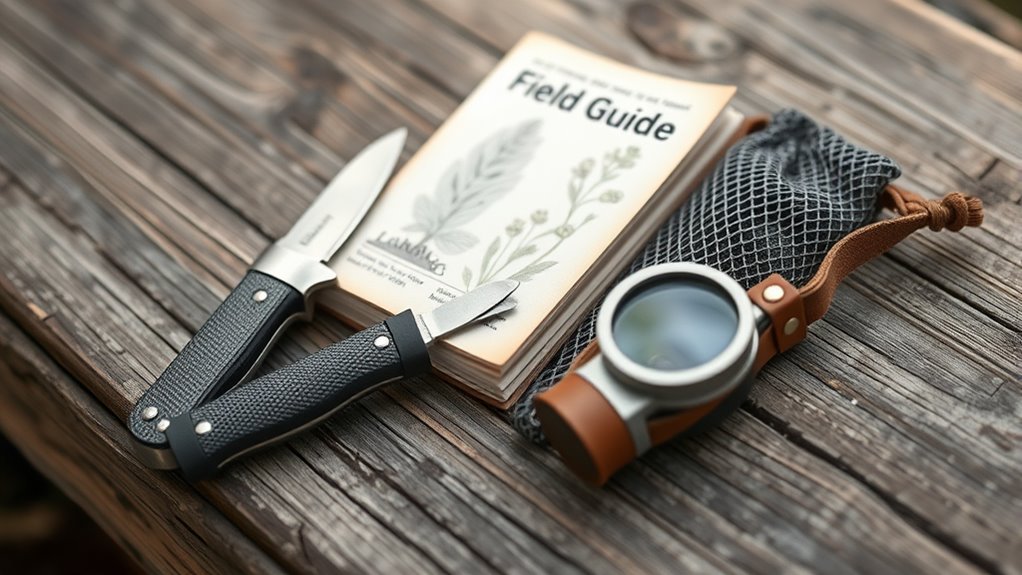
Ever wonder how to identify edible plants safely in the wild? Using reliable knowledge resources and field guides is essential to avoid wild food poisoning. These guides help you distinguish between safe and toxic plants, reducing risks during foraging. Look for reputable books, apps, and local expert resources that emphasize proper foraging ethics—respect the environment and avoid overharvesting. Familiarize yourself with key identifying features, habitats, and seasonal availability. Field guides should be lightweight and easy to carry, making them perfect for long treks. Remember, even with the best resources, never consume a plant unless you’re 100% sure of its edibility. Prioritize safety and ethical foraging to enjoy wild foods responsibly and sustainably.
Practical Techniques for Harvesting and Preparing Food

Mastering practical techniques for harvesting and preparing wild foods guarantees you get the most nutrition and safety from your foraged ingredients. Always follow foraging ethics by only collecting what you need and avoiding protected or endangered plants to support plant conservation. Use sharp scissors or knives to harvest sustainably, taking only parts of the plant and leaving enough for regeneration. When preparing foods, wash thoroughly to remove dirt and insects, and cook certain plants to improve digestibility and eliminate toxins. Be mindful of plant identification to avoid toxic look-alikes. Proper handling minimizes waste and preserves the environment. By respecting nature’s balance and applying safe harvesting and preparation methods, you ensure your foraging remains sustainable and safe throughout your trek.
Maintaining and Updating Your Foraging Kit
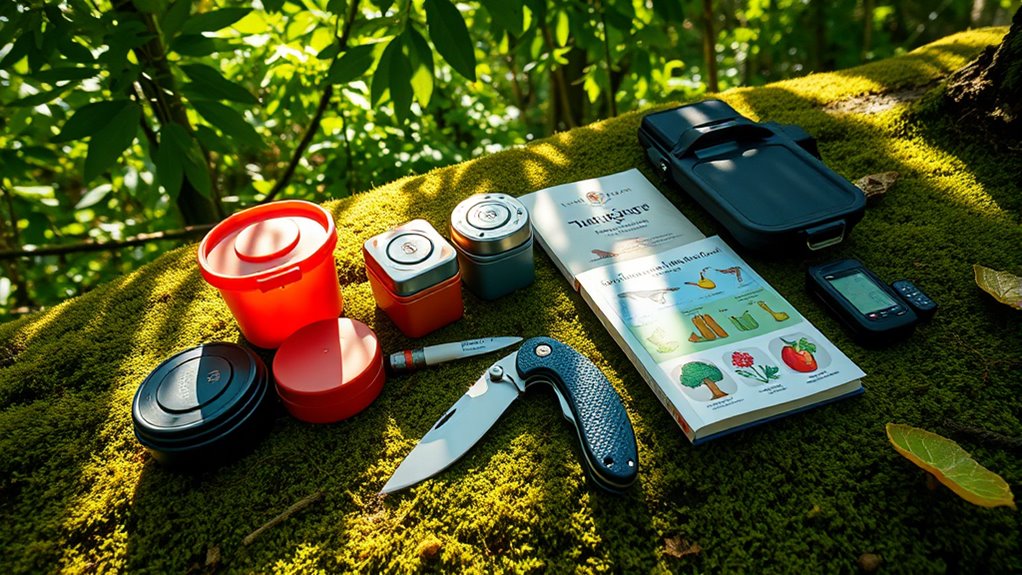
Regularly maintaining and updating your foraging kit guarantees it remains reliable and ready for any outing. Check your tools for wear, replace dull blades, and verify containers are clean. Review your plant identification skills to avoid misidentification, which is vital for ethical foraging. Keep a record of local edible plants and any changes in their habitats. Refresh your knowledge of foraging ethics to respect conservation efforts and avoid overharvesting. Consider adding new field guides or apps to improve accuracy. Periodically test your kit’s weight and functionality to stay true to your ultralight goals. These updates help prevent mistakes, guarantee safety, and keep you aligned with responsible foraging practices. Staying current ensures your kit supports safe, ethical, and successful foraging adventures.
Integrating Foraging Into Your Long-Distance Trek Plan
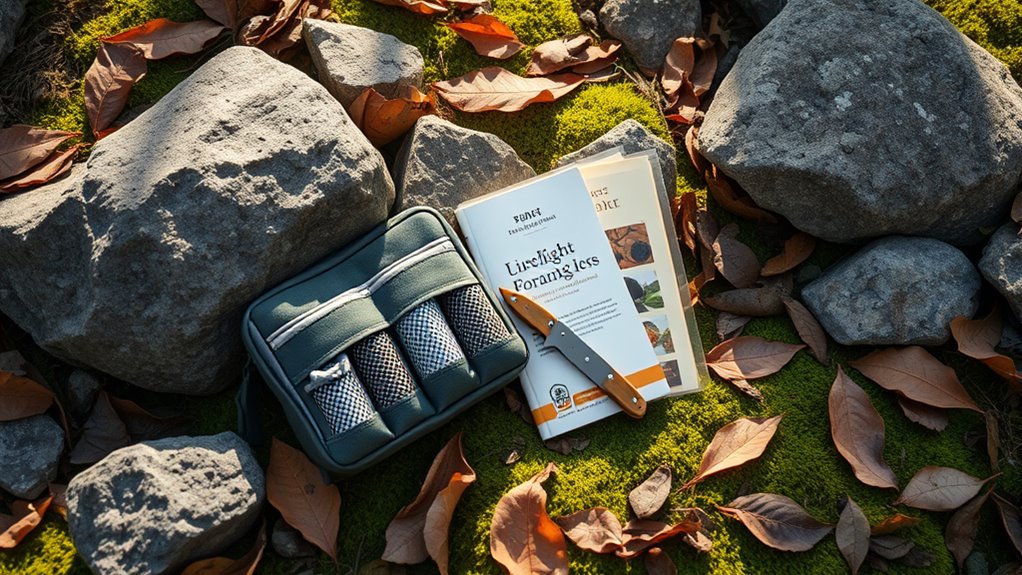
Integrating foraging into your long-distance trek plan requires careful coordination to guarantee it complements your overall route and schedule. Begin by researching areas rich in wild flora, ensuring they align with your path. Plan for specific foraging stops, balancing the time needed to gather food with travel goals. Always follow foraging ethics—harvesting sustainably and respecting local ecosystems—to avoid overharvesting and environmental damage. Keep in mind that foraging can supplement your diet but shouldn’t disrupt your progress or safety. Incorporate time for identification and collection into your daily routine, and be prepared to adapt if wild flora is scarce. Thoughtful integration ensures you enjoy fresh wild foods without compromising your trek’s efficiency or ecological integrity.
Tips for Maximizing Wild Food Opportunities
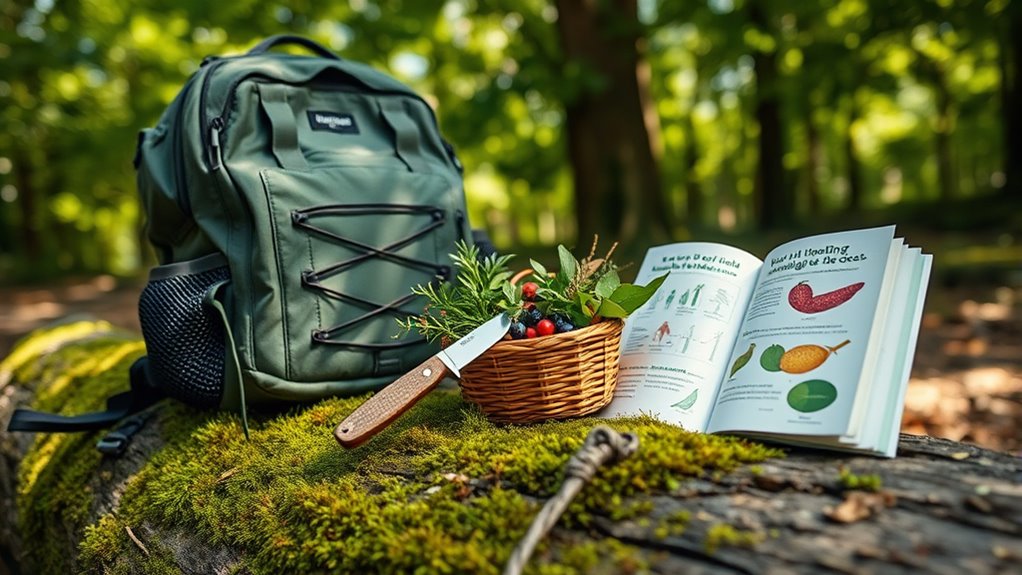
To make the most of wild food opportunities during your trek, it’s important to develop effective foraging strategies. Scouting ahead for seasonal abundance and learning about local edible plants can greatly boost your harvest. Always follow wild food ethics to ensure sustainability and minimize environmental impact. Use seasonal foraging strategies to target plants at their peak, increasing your chances of successful foraging.
Develop effective foraging strategies by researching local plants and respecting nature to maximize your wild food harvest responsibly.
Consider these tips:
- Research local edible plants before your trek
- Harvest only what you need to prevent overharvesting
- Avoid plants in heavily trafficked areas to reduce impact
- Identify plants accurately to prevent poisoning
- Respect wildlife and natural habitats during foraging
Sticking to these principles helps maximize your foraging while protecting the environment.
Frequently Asked Questions
How Do I Prevent Overharvesting While Foraging Long-Distance Treks?
To prevent overharvesting during your long-distance treks, practice sustainable harvesting and ethical foraging. Always take only what you need, leaving enough for the plants to regenerate, and avoid damaging the roots or surrounding vegetation. Identify and target abundant species, and respect local regulations. By following these principles, you help preserve ecosystems, ensuring the plants can thrive for future foragers and maintaining the balance of nature.
What Are the Best Ways to Carry Fresh Foraged Foods Safely?
Oh, the thrill of carrying fresh foraged foods on a trek—what could go wrong? You’d better pack them in sturdy portable containers to prevent squishing, and use temperature control methods like insulated bags or cool packs to keep them fresh. After all, nothing says “delicious” like biting into a soggy, spoiled snack. So, be smart, pack wisely, and enjoy your wild feast without risking a trail-side food fiasco.
How Can I Identify Rare or Toxic Plants Quickly?
When you’re trying to identify rare or toxic plants quickly, focus on plant identification techniques like noting leaf shape, color, and flower patterns. Use a reliable field guide or plant app to compare features, and pay attention to warning signs like milky sap or bitter taste. This helps you prevent toxic plant avoidance and ensures safe foraging. Practice regularly to sharpen your skills and become more confident in recognizing safe versus risky plants.
Are There Legal Restrictions on Foraging in Certain Areas?
Think of land access as the keys to a treasure chest—you need the right permits to open nature’s bounty. You should check local regulations because some areas require foraging permits, and certain lands may be off-limits. Always respect land boundaries and regulations, ensuring your foraging adventure remains legal and sustainable. Being informed about restrictions helps protect ecosystems and keeps your foraging journey smooth and rewarding.
How Do I Balance Foraging With Other Trekking Survival Priorities?
Balancing foraging with other trekking survival priorities requires you to practice foraging ethics and follow conservation strategies. Prioritize sourcing only what you need, avoid overharvesting, and identify edible plants correctly. This way, you guarantee your survival needs are met while protecting the environment. By respecting nature and using sustainable foraging methods, you maintain a healthy ecosystem and increase your chances of long-term success during your trek.
Conclusion
So, with your ultralight foraging kit, you’re all set to find free, wild food on your trek—just don’t forget, the best meal might be the one you *didn’t* harvest. Ironically, the lighter your pack, the less you carry, but that means fewer supplies to keep you safe and nourished. Embrace the challenge, enjoy the adventure, and remember: sometimes, the greatest find is the snack you left behind. Happy foraging!





